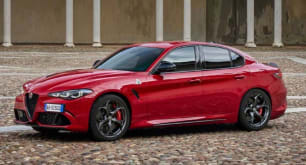Put simply: The Giulia is a celebration of Alfa Romeo. Yes. Even with a humble 2.0-litre turbocharged engine and an automatic transmission, this is a deeply emotional car. A riveting experience from behind the wheel.
Fly round corners, your eyes wide, exclaiming ‘magnifico!’ as the Giulia gracefully leans in, the rear LSD, sporty tyres, and wonderfully tight steering working together in harmony as you eke out just a smidge of tyre roar.
Laugh out loud to yourself, as you plant the accelerator, hear the muted rumble of the surprisingly angry little engine, and feel the turbocharger kick in half a second later as you power out.
‘Eccezionale!’ You’ll think, as you feel the click of the immensely satisfying metal paddle-shifters, and the transmission responds in-kind, the engine roaring up the revolutions with enthusiasm.
Sure, the Veloce grade is not as raw, or as wild, or near as fast as the top-grade Quadrofoglio, but all of the exciting spirit of that car is still here, and at a little over half the price, too. The Veloce is an absolute delight to drive.
It has such poise, makes such a fine sound, and does it all so gracefully. This is how you make a car feel as one with the driver.
Even the ride is deeply impressive. It’s not too harsh or noisy, while gifting the chassis just the right amount of lean in the corners and allowing enough play for it to remain controlled over bumps.
Not only does it work well when you’re driving as it's clearly intended to be driven, but around town it’s quiet and refined inside, living up to the promise of a luxury sedan.
The seats and bolstering are great, the visibility isn’t too bad, and while I’ll complain about the slightly laggy software on the multimedia screen, the digital dash is responsive and the physical climate controls are welcome.
It’s not all perfect. If it were, I think it might cease to be an Alfa Romeo and start sprouting BMW badges.
For example, our test car, with less than 2000km on the odometer, had various inconsistent rattles emanating from the plastic garnish around the digital dash, and somewhere behind the back seat.
Regardless, driving this car has made me a little sad Alfa will be putting this wonderful platform behind it in pursuit of more electrified goals.
I can only hope wherever the Giulia nameplate goes next, it retains the spirit of this version.





















































